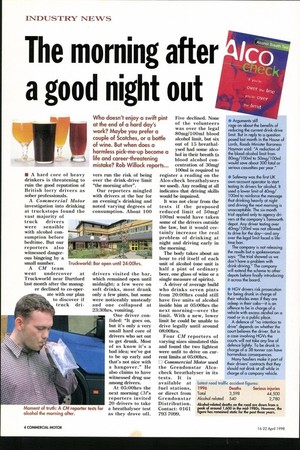The morning after a good night out Who doesn't enjoy
Page 6

If you've noticed an error in this article please click here to report it so we can fix it.
a swift pint at the end of a hard day's work? Maybe you prefer a couple of Scotches, or a bottle of wine. But when does a harmless pick-me-up become a life and career-threatening mistake? Rob Willock reports...
• A hard core of heavy drinkers is threatening to ruin the good reputation of British lorry drivers as sober professionals.
A Commercial Motor investigation into drinking at truckstops found the vast majority of truck drivers were sensible with alcohol consumption before bedtime. But our reporters also witnessed dangerous bingeing by a small number.
A CM team went undercover at Truckworld near Dartford last month after the manager declined to co-operate with our plan to discover if truck dri vets run the risk of being over the drink-drive limit "the morning after".
Our reporters mingled with drivers at the bar for an evening's drinking and noted varying degrees of consumption. About 100 drivers visited the bar, which remained open until midnight; a few were on soft drinks, most drank only a few pints, but some were noticeably unsteady and one collapsed at 23:30hrs, vomiting.
One driver confided: "It goes on, but it's only a very small hard core of drivers who set out to get drunk. Most of us know it's a bad idea; we've got to be up early and that's not nice with a hangover." He also claims to have witnessed drug use among drivers.
At 05:00hrs the next morning CM's reporters invited 20 drivers to take a breathalyser test as they drove off. Five declined. None of the volunteers was over the legal 80mg/100m1 blood alcohol limit, but six out of 15 breathalysed had some alcohol in their breath (a blood alcohol concentration of 30mg/ 100m1 is required to register a reading on the Alco-check breathalysers we used). Any reading at all indicates that driving skills would be impaired.
It was not clear from the tests if the proposed reduced limit of 50mg/ 100m1 would have taken some of the drivers outside the law, but it would certainly increase the real problem of drinking at night and driving early in the morning.
The body takes about an hour to rid itself of each unit of alcohol (one unit is half a pint of ordinary beer, one glass of wine or a single measure of spirits).
A driver of average build who drinks seven pints from 20:00hrs could still have five units of alcohol inside him at 05:00hrs the next morning—over the limit. With a new, lower limit he could be unable to drive legally until around 08:00hrs.
Four CM reporters of varying sizes simulated this and found the two lightest were unfit to drive on current limits at 05:00hrs. Arguments still rage on about the benefits of reducing the current drink-drive limit. But in reply to a question posed last month in the House of Lords, Roads Minister Baroness Hayman said: "A reduction of the blood alcohol limit from 80mg/100m1 to 50mg/100m1 would save about 300 fatal or serious casualties per year."
Safeway was the first UK own-account operator to start testing its drivers for alcohol. It used a lower limit of 40mg/ 100m1 to reinforce the message that drinking heavily at night and driving the next morning is unacceptable. The six-month trial applied only to agency drivers at the company's Tamworth depot. Any driver testing over 40mg/100m1was not allowed to drive for the day—and any over the legal limit faced a lifetime ban.
The company is not releasing the results but a spokeswoman says: "The trial showed us we don't have a problem with drink-driving." The company will extend the scheme to other depots before finally introducing it across the board.
HGV drivers risk prosecution for being drunk in charge of their vehicles even if they are asleep in their cabs—it is an offence to be in charge of a vehicle with excess alcohol on a road or in a public place. A defence of "no intention to drive" depends on whether the court believes the driver. But in a case involving HGVs the courts will not take any line of defence lightly. To be drunk in charge of a 38-tonner can have horrendous consequences.
Many hauliers make it part of their drivers' contracts that they should not drink at all while in charge of a company vehicle.
Latest road traffic accident figures: 1996 Deaths Serious injuries Total 3,598 44,500 Alcohol related 540 2,780 Alcohol-related deaths on the road are down from a peak of around 1,600 in the mid-1980s. However, the Figure has remained static for the past three years.




































































































